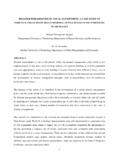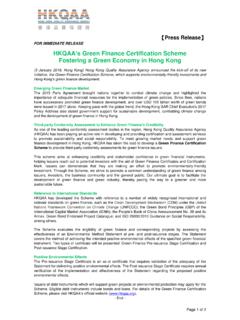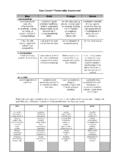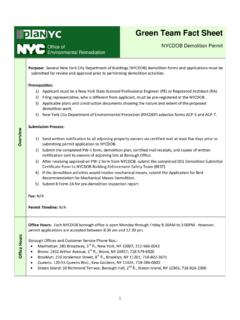Transcription of Green Paper on Disaster Management
1 Green Paper on Disaster Management Contents Call to all stakeholders Foreword by the Minister of Provincial Affairs and Constitutional Development Disaster Management task team List of abbreviations Preface: The Green Paper process How to read the Green Paper 1. Introduction The South African context International framework Aim of the process towards a national policy for Disaster Management Conceptual framework Linkages between disasters and development Underlying causes of disasters 2. Key principles for a Disaster - Management policy 3. Different approaches to Disaster Management General approaches to the Management of disasters Key elements of Disaster Management 4.
2 Current situation in managing disasters Part One: How disasters are dealt with currently by government Drought Floods and dam failures Fire hazards Bomb explosions and civil unrest Refugees and displaced people Epidemics and other health disasters Earthquakes, dolomite land, nuclear radiation Aircraft, maritime, road and railway disasters Hazardous material, pollution, tropical cyclones and tornadoes Part Two: Other national departments and agencies involved in Disaster Management Department of Constitutional Development The South African Weather Bureau The SANDF and SAPS. Department of Welfare and Population Development Department of Housing Department of Education Department of Public Works Part Three: Summary of general weaknesses and constraints in current Disaster Management Part Four: Legislative framework 5.
3 Ensuring that a system for Disaster Management is in place Analysing the problem with the current system Integrative support mechanisms for Disaster Management Better resource Management Early-warning systems and information systems Communication The role of the media Budgeting for Disaster Management and insurance Use of financial incentives Research Training and education Planning and setting of standards International agencies for liaison and cooperation 6. Inter-governmental and civil society cooperation and coordination Role of national government Role of provincial government Role of local government Role of non-governmental organisations, community-based organisations and the private sector The creation of a national Disaster - Management centre 7.
4 Glossary CALL TO ALL STAKEHOLDERS. To all heads of departments at the national, provincial and local government levels and other stakeholders in the non-governmental, community-based organisation and private sectors and interested parties who deal with or are affected by Disaster - Management issues: Your participation is requested in developing a policy framework for Disaster Management . General directions on how to read the document are provided. All issues and points of debate that you want to raise or comment on should be submitted to the following address: Green Paper Secretariat for Disaster Management Private Bag X804.
5 Pretoria 0002. Fax: (012) 334-0610. Phone: (012) 334-0600. e-mail: Any queries and requests can be referred to the above contacts. All submissions must be forwarded by 30 April 1998. Thank you for you participation. Foreword by Mohammed Valli Moosa, Minister of Provincial Affairs and Constitutional Development Throughout our history, disasters have inflicted a heavy cost in human, material and physical resources, and damage to the environment. They represent a potentially significant obstacle to economic growth and development. A Disaster is an event which disrupts the daily life of the population of a community or country and can result in substantial loss of life and social upheaval, leading to many persons becoming homeless, helpless and hungry.
6 The situation is further aggravated by the disruption, dislocation or loss of vital economic production and national infrastructure, including water and power supplies, communications and transportation. Disasters occur when hazards impact on a community to the extent that available resources cannot cope with the problem effectively. The community itself needs support and assistance to prevent and cope with disasters and their effects. Adequate procedures to deal with Disaster situations and relief measures must be planned prior to the event, with strong legislation to empower those responsible to carry out the tasks.
7 Regular training must be conducted covering all aspects of Disaster Management . Careful planning must be in place to coordinate the effective use of resources, both human and physical, for the saving of lives and property, limiting damage to the environment, and the return to a normal life style as soon as possible. The development of Disaster - Management strategies must be undertaken before the event. Disaster Management requires effective community-based strategies which will include programmes and measures to: _ Prevent or reduce the severity of hazard impact. _ Ensure the preparedness of the arrangements and of the community itself.
8 _ Provide an effective response should impact occur. _ Provide for the recovery of a community affected by such an impact. Measures must also be in place to request and receive assistance from outside the country. Many authorities and organisations are routinely involved in dealing with incidents and disasters which arise when natural or technological hazards impact on our communities. An active partnership between national provincial and local governments, statutory and voluntary organisations and communities is needed in order to develop and implement effective Disaster - Management strategies.
9 The role of national government is to provide guidance and support to the provincial and local governments in developing their capacity for dealing with disasters, and to provide physical assistance if requested. The aim of the Green Paper on Disaster Management is to ensure that an effective Disaster - Management system is realised and implemented by way of national policy which will be reflected in the White Paper . The Green Paper on Disaster Management is presented to you for your comments and recommendations. We therefore invite you to respond to ensure that the views of all South Africans are reflected in the White Paper .
10 I take this opportunity to thank everyone who has contributed in the Green Paper process up to now and those from whom comments are awaited. A special word of appreciation is conveyed to Ms Janet Love (MP) who was willing to take on the responsibility of coordinating the Green Paper process. Disaster Management TASK TEAM. CHAIRPERSON. Ms Janet Love (MP). SECRETARIAT. Department of Constitutional Development: Directorate: Disaster Management (Peet Stopforth , Servaas de Kock, and Saar van Wyk). DRAFTER OF Green Paper . Mr Saliem Fakir DRAFTING TEAM. National departments: Department of Water Affairs and Forestry (Mr Chris Swiegers).












